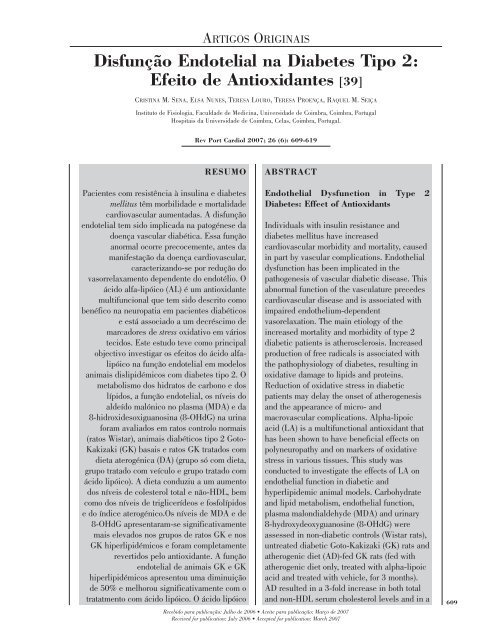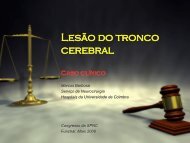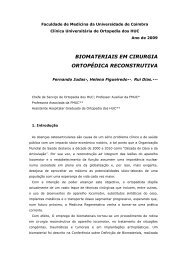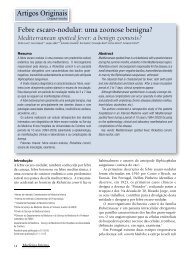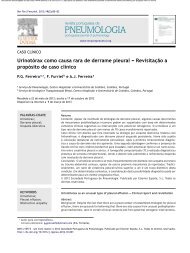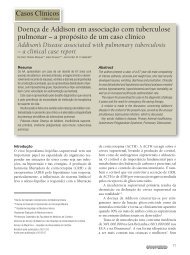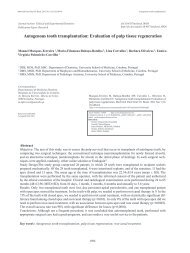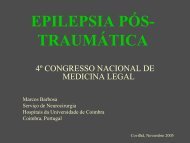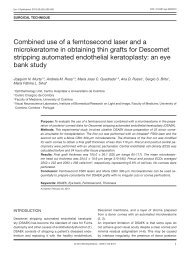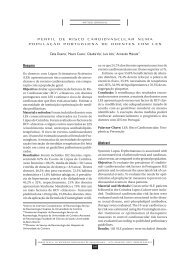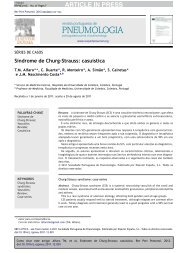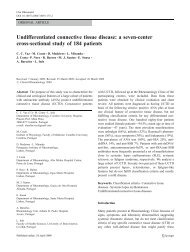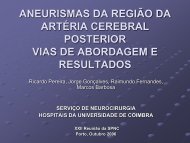Disfunção Endotelial na Diabetes Tipo 2: Efeito de ... - RIHUC
Disfunção Endotelial na Diabetes Tipo 2: Efeito de ... - RIHUC
Disfunção Endotelial na Diabetes Tipo 2: Efeito de ... - RIHUC
Create successful ePaper yourself
Turn your PDF publications into a flip-book with our unique Google optimized e-Paper software.
ARTIGOS ORIGINAIS<br />
<strong>Disfunção</strong> <strong>Endotelial</strong> <strong>na</strong> <strong>Diabetes</strong> <strong>Tipo</strong> 2:<br />
<strong>Efeito</strong> <strong>de</strong> Antioxidantes [39]<br />
CRISTINA M. SENA, ELSA NUNES, TERESA LOURO, TERESA PROENÇA, RAQUEL M. SEIÇA<br />
Instituto <strong>de</strong> Fisiologia, Faculda<strong>de</strong> <strong>de</strong> Medici<strong>na</strong>, Universida<strong>de</strong> <strong>de</strong> Coimbra, Coimbra, Portugal<br />
Hospitais da Universida<strong>de</strong> <strong>de</strong> Coimbra, Celas, Coimbra, Portugal.<br />
Rev Port Cardiol 2007; 26 (6): 609-619<br />
RESUMO<br />
Pacientes com resistência à insuli<strong>na</strong> e diabetes<br />
mellitus têm morbilida<strong>de</strong> e mortalida<strong>de</strong><br />
cardiovascular aumentadas. A disfunção<br />
endotelial tem sido implicada <strong>na</strong> patogénese da<br />
doença vascular diabética. Essa função<br />
anormal ocorre precocemente, antes da<br />
manifestação da doença cardiovascular,<br />
caracterizando-se por redução do<br />
vasorrelaxamento <strong>de</strong>pen<strong>de</strong>nte do endotélio. O<br />
ácido alfa-lipóico (AL) é um antioxidante<br />
multifuncio<strong>na</strong>l que tem sido <strong>de</strong>scrito como<br />
benéfico <strong>na</strong> neuropatia em pacientes diabéticos<br />
e está associado a um <strong>de</strong>créscimo <strong>de</strong><br />
marcadores <strong>de</strong> stress oxidativo em vários<br />
tecidos. Este estudo teve como principal<br />
objectivo investigar os efeitos do ácido alfalipóico<br />
<strong>na</strong> função endotelial em mo<strong>de</strong>los<br />
animais dislipidémicos com diabetes tipo 2. O<br />
metabolismo dos hidratos <strong>de</strong> carbono e dos<br />
lípidos, a função endotelial, os níveis do<br />
al<strong>de</strong>ído malónico no plasma (MDA) e da<br />
8-hidroxi<strong>de</strong>soxiguanosi<strong>na</strong> (8-OHdG) <strong>na</strong> uri<strong>na</strong><br />
foram avaliados em ratos controlo normais<br />
(ratos Wistar), animais diabéticos tipo 2 Goto-<br />
Kakizaki (GK) basais e ratos GK tratados com<br />
dieta aterogénica (DA) (grupo só com dieta,<br />
grupo tratado com veículo e grupo tratado com<br />
ácido lipóico). A dieta conduziu a um aumento<br />
dos níveis <strong>de</strong> colesterol total e não-HDL, bem<br />
como dos níveis <strong>de</strong> triglicerí<strong>de</strong>os e fosfolípidos<br />
e do índice aterogénico.Os níveis <strong>de</strong> MDA e <strong>de</strong><br />
8-OHdG apresentaram-se significativamente<br />
mais elevados nos grupos <strong>de</strong> ratos GK e nos<br />
GK hiperlipidémicos e foram completamente<br />
revertidos pelo antioxidante. A função<br />
endotelial <strong>de</strong> animais GK e GK<br />
hiperlipidémicos apresentou uma diminuição<br />
<strong>de</strong> 50% e melhorou significativamente com o<br />
tratatmento com ácido lipóico. O ácido lipóico<br />
ABSTRACT<br />
Endothelial Dysfunction in Type 2<br />
<strong>Diabetes</strong>: Effect of Antioxidants<br />
Individuals with insulin resistance and<br />
diabetes mellitus have increased<br />
cardiovascular morbidity and mortality, caused<br />
in part by vascular complications. Endothelial<br />
dysfunction has been implicated in the<br />
pathogenesis of vascular diabetic disease. This<br />
abnormal function of the vasculature prece<strong>de</strong>s<br />
cardiovascular disease and is associated with<br />
impaired endothelium-<strong>de</strong>pen<strong>de</strong>nt<br />
vasorelaxation. The main etiology of the<br />
increased mortality and morbidity of type 2<br />
diabetic patients is atherosclerosis. Increased<br />
production of free radicals is associated with<br />
the pathophysiology of diabetes, resulting in<br />
oxidative damage to lipids and proteins.<br />
Reduction of oxidative stress in diabetic<br />
patients may <strong>de</strong>lay the onset of atherogenesis<br />
and the appearance of micro- and<br />
macrovascular complications. Alpha-lipoic<br />
acid (LA) is a multifunctio<strong>na</strong>l antioxidant that<br />
has been shown to have beneficial effects on<br />
polyneuropathy and on markers of oxidative<br />
stress in various tissues. This study was<br />
conducted to investigate the effects of LA on<br />
endothelial function in diabetic and<br />
hyperlipi<strong>de</strong>mic animal mo<strong>de</strong>ls. Carbohydrate<br />
and lipid metabolism, endothelial function,<br />
plasma malondial<strong>de</strong>hy<strong>de</strong> (MDA) and uri<strong>na</strong>ry<br />
8-hydroxy<strong>de</strong>oxyguanosine (8-OHdG) were<br />
assessed in non-diabetic controls (Wistar rats),<br />
untreated diabetic Goto-Kakizaki (GK) rats and<br />
atherogenic diet (AD)-fed GK rats (fed with<br />
atherogenic diet only, treated with alpha-lipoic<br />
acid and treated with vehicle, for 3 months).<br />
AD resulted in a 3-fold increase in both total<br />
and non-HDL serum cholesterol levels and in a<br />
Recebido para publicação: Julho <strong>de</strong> 2006 • Aceite para publicação: Março <strong>de</strong> 2007<br />
Received for publication: July 2006 • Accepted for publication: March 2007<br />
609
610<br />
Rev Port Cardiol<br />
Vol. 26 Junho 07 / June 07<br />
reverteu também os níveis lipídicos (colesterol<br />
total, colesterol não-HDL, triglicerí<strong>de</strong>os e<br />
fosfolípidos) e o índice aterogénico, sem afectar<br />
o colesterol HDL. Suplementos <strong>de</strong> ácido<br />
lipóico po<strong>de</strong>rão assim representar um<br />
importante adjuvante <strong>na</strong> terapêutica <strong>de</strong><br />
pacientes hiperlipidémicos com diabetes<br />
mellitus tipo 2, <strong>na</strong> medida em que conduz a<br />
aumentos significativos da função endotelial e<br />
a uma importante redução dos níveis <strong>de</strong> stress<br />
oxidativo e do índice aterogénico, factores que<br />
estão implicados <strong>na</strong> patogénese da<br />
aterosclerose <strong>na</strong> diabetes.<br />
Palavras-Chave<br />
<strong>Disfunção</strong> endotelial; <strong>Diabetes</strong> tipo 2; Aterosclerose;<br />
Stress oxidativo; Antioxidantes<br />
INTRODUÇÃO<br />
Adislipi<strong>de</strong>mia e a sua relação com a doença<br />
coronária aterosclerótica e a disfunção<br />
endotelial tem sido <strong>de</strong>monstrada em múltiplos<br />
ensaios clínicos (1-3) . Por outro lado, a redução <strong>de</strong><br />
eventos coronários e a estabilização ou mesmo a<br />
regressão da doença aterosclerótica através <strong>de</strong><br />
drogas redutoras do colesterol plasmático,<br />
também têm sido referidas por inúmeros<br />
estudos (4-9) . Os mecanismos envolvidos <strong>na</strong><br />
redução dos eventos coronários, quando ocorre<br />
diminuição do colesterol plasmático, parecem<br />
estar relacio<strong>na</strong>dos com a reversão da<br />
disfunção endotelial e a estabilização da placa<br />
<strong>de</strong> aterosclerose, uma vez que não se observa<br />
um aumento significativo do diâmetro vascular<br />
ao nível da placa aterosclerótica (8) . Funções<br />
importantes são atribuídas ao endotélio vascular,<br />
como a manutenção do tónus vascular, o<br />
equilíbrio entre a coagulação e a fibrinólise e a<br />
modulação da inflamação e da agregação<br />
plaquetar (8) . O endotélio tem uma função<br />
autócri<strong>na</strong>/parácri<strong>na</strong>, reguladora da secreção <strong>de</strong><br />
múltiplos factores relaxantes (óxido nítrico / NO)<br />
e prostacicli<strong>na</strong>) e constritores (endoteli<strong>na</strong>s).<br />
O factor relaxante melhor caracterizado e<br />
mais importante é o NO. O NO tem uma produção<br />
e libertação basais, e uma outra <strong>de</strong>pen<strong>de</strong>nte da<br />
influência <strong>de</strong> vários agonistas (acetilcoli<strong>na</strong>,<br />
bradicini<strong>na</strong>, substância P e serotoni<strong>na</strong>, entre<br />
2-fold increase triglyceri<strong>de</strong> levels while<br />
endothelial function was significantly reduced.<br />
MDA and 8-OHdG levels were higher in the<br />
GK and GK hyperlipi<strong>de</strong>mic groups and were<br />
completely reversed by the antioxidant.<br />
Hyperlipi<strong>de</strong>mic GK diabetic rats showed<br />
significantly reduced endothelial function that<br />
was partially improved with LA. Furthermore,<br />
lipoic acid significantly reduced serum<br />
cholesterol levels, without lowering HDL<br />
cholesterol. Alpha-lipoic acid supplementation<br />
represents an achievable adjunct therapy to<br />
improve endothelial function and reduce<br />
oxidative stress, factors that are implicated in<br />
the pathogenesis of atherosclerosis in diabetes.<br />
Key words<br />
Endothelial dysfunction; Type 2 diabetes; Atherosclerosis;<br />
Oxidative stress; Antioxidants<br />
INTRODUCTION<br />
The link between dyslipi<strong>de</strong>mia and<br />
atherosclerotic coro<strong>na</strong>ry disease and<br />
endothelial dysfunction has been <strong>de</strong>monstrated in<br />
many clinical trials (1-3) . At the same time, it has<br />
been shown in various studies that the use of<br />
cholesterol-lowering drugs leads to a reduction in<br />
coro<strong>na</strong>ry events and stabilization or even<br />
regression of atherosclerotic disease (4-9) . The<br />
mechanisms by which cholesterol lowering<br />
reduces coro<strong>na</strong>ry events appear to be related to<br />
reversal of endothelial dysfunction and to plaque<br />
stabilization, since no significant increase in<br />
lumen diameter is seen at the plaque site (8) .<br />
Vascular endothelium has important functions<br />
such as mainte<strong>na</strong>nce of vascular tone and<br />
coagulation-fibrinolysis balance, and modulation<br />
of inflammation and platelet aggregation (8) . The<br />
endothelium has both autocrine and paracrine<br />
actions, regulating the secretion of various<br />
relaxing factors, mainly nitric oxi<strong>de</strong> (NO) and<br />
prostacyclin, as well as constrictors such as<br />
endothelin.<br />
The most important relaxing factor, and the<br />
most thoroughly studied, is NO. NO is constantly<br />
being produced and released, but this is affected<br />
by various agonists, including acetylcholine,<br />
bradykinin, substance P and serotonin. Endothelium-<strong>de</strong>pen<strong>de</strong>nt<br />
vasodilation is impaired in<br />
individuals with coro<strong>na</strong>ry atherosclerosis and in
outros). A vasodilatação <strong>de</strong>pen<strong>de</strong>nte do endotélio<br />
não está íntegra em indivíduos com aterosclerose<br />
coronária e em doentes com factores <strong>de</strong> risco<br />
coronários como a hipercolesterolemia, diabetes<br />
mellitus, hábitos tabágicos e hipertensão arterial (8) .<br />
Mais recentemente, tem-se verificado que as<br />
substâncias antioxidantes são capazes <strong>de</strong> reverter<br />
a disfunção endotelial provocada pela diabetes<br />
associada a dislipi<strong>de</strong>mia (10-13) e <strong>de</strong> reduzir também<br />
o número <strong>de</strong> eventos coronários (12, 13) , embora a<br />
sua utilização, <strong>na</strong> prática médica, necessite,<br />
ainda, <strong>de</strong> informações mais conclusivas.<br />
Perante estas evidências, a redução dos<br />
lípidos plasmáticos assume um importante papel<br />
no controlo da doença aterosclerótica. O controlo<br />
da dieta constitui o ponto fundamental dos<br />
distúrbios lipídicos mais frequentes. Estudos<br />
como o <strong>de</strong> Jenkins e colaboradores (14) sugerem<br />
que <strong>de</strong>termi<strong>na</strong>das dietas com antioxidantes<br />
po<strong>de</strong>rão por si só reduzir a dislipi<strong>de</strong>mia em<br />
<strong>de</strong>termi<strong>na</strong>dos pacientes. Consi<strong>de</strong>rando o elevado<br />
custo dos fármacos hipolipemiantes e a<br />
perspectiva do seu uso prolongado, os pacientes<br />
têm recorrido a tratamentos alter<strong>na</strong>tivos para o<br />
controlo da dislipi<strong>de</strong>mia. Estes tratamentos têm<br />
sido utilizados <strong>de</strong> forma empírica pela população,<br />
necessitando <strong>de</strong> uma metodologia <strong>de</strong> estudo que<br />
permita conclusões mais fi<strong>de</strong>dig<strong>na</strong>s. Assim,<br />
antioxidantes com as vitami<strong>na</strong>s C e E têm sido<br />
extensamente avaliados.<br />
O ácido α-lipóico é um antioxidante<br />
metabólico com características lipo e hidrossolúveis.<br />
É um potente sequestrador <strong>de</strong> radicais<br />
livres e recicla outras vitami<strong>na</strong>s facilitando a sua<br />
função antioxidante (15) . Em humanos, os efeitos do<br />
ácido lipóico, administrado por diferentes vias, já<br />
foram avaliados em diferentes estudos, sendo<br />
seguros e promissores os benefícios da sua<br />
utilização terapêutica nomeadamente <strong>na</strong><br />
polineuropatia diabética (31, 32) .<br />
O efeito do ácido α-lipóico <strong>na</strong> dislipi<strong>de</strong>mia e<br />
<strong>na</strong> função endotelial associadas à diabetes tipo 2,<br />
representou o principal objectivo <strong>de</strong>ste estudo. A<br />
produção aumentada <strong>de</strong> radicais livres está<br />
associada à fisiopatologia da diabetes mellitus,<br />
resultando em lesão oxidativa das proteí<strong>na</strong>s e<br />
lipídos. Assim, também foram avaliados os níveis<br />
<strong>de</strong> stress oxidativo nos mo<strong>de</strong>los animais<br />
diabéticos.<br />
those with coro<strong>na</strong>ry risk factors such as<br />
hypercholesterolemia, diabetes, smoking, or<br />
hypertension (8) .<br />
It has recently been <strong>de</strong>monstrated that<br />
antioxidants can reverse endothelial dysfunction<br />
caused by diabetes associated with<br />
dyslipi<strong>de</strong>mia (10-13) and also reduce the number of<br />
coro<strong>na</strong>ry events (12, 13) , although there is a need for<br />
more conclusive evi<strong>de</strong>nce of their usefulness in<br />
clinical practice.<br />
Given these facts, reduction of plasma lipids<br />
has an important part to play in controlling<br />
atherosclerotic disease. Diet is the main factor in<br />
the commonest lipid disor<strong>de</strong>rs; studies such as<br />
those by Jenkins et al. (14) suggest that a diet rich<br />
in antioxidants can by itself reduce dyslipi<strong>de</strong>mia<br />
in certain patients. The high cost of lipidlowering<br />
drugs and the prospect of their longterm<br />
use have led some patients to turn to<br />
alter<strong>na</strong>tive treatments to control their dyslipi<strong>de</strong>mia.<br />
Such treatments have been used<br />
empirically, and so there is a need for more<br />
rigorous research that will provi<strong>de</strong> reliable<br />
information, and antioxidants such as vitamins C<br />
and E have been extensively studied in this<br />
context.<br />
Alpha-lipoic acid (LA) is a fat- and watersoluble<br />
metabolic antioxidant that is a potent<br />
free radical scavenger and also recycles<br />
other vitamins, strengthening their antioxidant<br />
action (15) . The effects of LA in humans,<br />
administered in different ways, have been<br />
assessed in various studies; it appears to be safe<br />
and to have promising benefits, especially in the<br />
treatment of diabetic polyneuropathy (31, 32) .<br />
The main objective of this study was to<br />
investigate the effect of alpha-lipoic acid on<br />
dyslipi<strong>de</strong>mia and endothelial function in type 2<br />
diabetes. Increased production of free radicals is<br />
associated with the pathophysiology of diabetes,<br />
resulting in oxidative damage to proteins and<br />
lipids. Levels of oxidative stress were accordingly<br />
also measured in the diabetic animal mo<strong>de</strong>ls<br />
used.<br />
METHODS<br />
CRISTINA M. SENA, et al<br />
Rev Port Cardiol 2007; 26: 609-19<br />
Animals<br />
Fifteen-month-old diabetic rats (Goto-<br />
Kakizaki [GK], an animal mo<strong>de</strong>l of non-obese<br />
spontaneous type 2 diabetes) were fed ad libitum 611
612<br />
Rev Port Cardiol<br />
Vol. 26 Junho 07 / June 07<br />
MATERIAL E MÉTODOS<br />
Animais<br />
Ratos diabéticos (Goto-Kakizaki -GK; um<br />
mo<strong>de</strong>lo animal espontâneo <strong>de</strong> diabetes tipo 2 não<br />
obesa) com 15 meses foram alimentados, durante<br />
3 meses, ad libitum com ração standard (3%<br />
gorduras, tipo AO4-Panlab) ou com ração<br />
enriquecida em colesterol e gorduras (DA: 7.5%<br />
gordura e 1.25% colesterol) e livre acesso a água.<br />
Cinco grupos <strong>de</strong> animais (n=7-10 por grupo)<br />
foram estudados: ratos não diabéticos controlo<br />
(ratos Wistar), ratos diabéticos controlo (GK);<br />
ratos GK com dieta aterogénica (GK+DA); ratos<br />
GK com DA e óleo <strong>de</strong> soja/veículo (OS) e ratos<br />
GK com DA e ácido lipóico (AL). A quantida<strong>de</strong><br />
<strong>de</strong> água e ração ingerida foi quantificada antes e<br />
no fi<strong>na</strong>l do tratamento. Amostras <strong>de</strong> sangue, em<br />
animais anestesiados, foram obtidas por punção<br />
cardíaca para <strong>de</strong>termi<strong>na</strong>ção da bioquímica<br />
do sangue e as uri<strong>na</strong>s (24h) recolhidas em<br />
caixas metabólicas para <strong>de</strong>termi<strong>na</strong>ção da<br />
8-hidroxi<strong>de</strong>soxiguanosi<strong>na</strong> (8-OHdG).<br />
Parâmetros bioquímicos e <strong>de</strong> stress oxidativo<br />
Foram <strong>de</strong>termi<strong>na</strong>dos, antes e no fi<strong>na</strong>l do<br />
tratamento, os pesos corporais e a glicemia após<br />
um jejum <strong>de</strong> 16-18 horas. Foi igualmente<br />
<strong>de</strong>termi<strong>na</strong>da a glicemia 2 h após administração<br />
<strong>de</strong> soro glicosado a 30%, por via intraperitoneal<br />
(1,75g <strong>de</strong> glicose/Kg peso corporal). As<br />
concentrações da glicose no sangue total foram<br />
<strong>de</strong>termi<strong>na</strong>das <strong>na</strong> veia da cauda pelo método da<br />
glicose-oxidase (glicómetro e tiras teste - Bayer,<br />
Portugal) e expressas em mg/dl. No fi<strong>na</strong>l do<br />
tratamento foram <strong>de</strong>termi<strong>na</strong>das as concentrações<br />
sanguíneas <strong>de</strong> colesterol total, colesterol-HDL,<br />
triglicerí<strong>de</strong>os e fosfolípidos, por a<strong>na</strong>lisador<br />
automático. O índice aterogénico (AI) foi<br />
calculado utilizando a fórmula, colesterol<br />
total/colesterol-HDL (CT/C-HDL). O al<strong>de</strong>ído<br />
malónico (MDA) no plasma e a 8-OHdG <strong>na</strong> uri<strong>na</strong><br />
foram <strong>de</strong>termi<strong>na</strong>dos por HPLC e por ELISA,<br />
respectivamente, como previamente <strong>de</strong>scrito (16) .<br />
Para a <strong>de</strong>termi<strong>na</strong>ção da peroxidação lipídica<br />
da pare<strong>de</strong> arterial utilizou-se o método <strong>de</strong> Cassini<br />
e colaboradores (17) . Segmentos da aorta torácica<br />
foram homogeneizados com ácido tricloroacético<br />
(mg <strong>de</strong> tecido por ml <strong>de</strong> TCA a 10%). Após<br />
centrifugação, foi adicio<strong>na</strong>do um volume <strong>de</strong> ácido<br />
tiobarbitúrico 0,67% sendo a mistura aquecida a<br />
100ºC durante 20min. A concentração <strong>de</strong> MDA<br />
for 3 months on standard chow (Panlab AO4, 3%<br />
fat) or high cholesterol and fat chow (atherogenic<br />
diet [AD], 7.5% fat and 1.25% cholesterol), with<br />
free access to water. Five groups (n=7-10 per<br />
group) were studied: non-diabetic controls<br />
(Wistar rats), diabetic controls (GK), GK rats on<br />
the atherogenic diet (GK+AD), GK rats on AD<br />
and soya oil vehicle (SO), and GK rats on AD and<br />
lipoic acid (AL). The quantity of water and food<br />
ingested was measured before and at the end of<br />
the treatment. Blood samples were taken from<br />
anesthetized animals by cardiac puncture to<br />
a<strong>na</strong>lyze blood biochemistry, and 24-hour urine<br />
samples were obtained in metabolic cages to<br />
measure 8- hydroxy<strong>de</strong>oxyguanosine (8-OHdG).<br />
Biochemical and oxidative stress parameters<br />
Body weight and 16-18-hour fasting glycemia<br />
were measured before and at the end of the<br />
treatment, as was glycemia after intraperitoneal<br />
administration of 30% glucose solution (1.75 g<br />
glucose/kg). Whole blood glucose was measured<br />
in the caudal vein using the glucose oxidase<br />
method (glucometer and test strips from Bayer,<br />
Portugal) and expressed in mg/dl. At the end of<br />
the treatment blood concentrations of total and<br />
HDL cholesterol, triglyceri<strong>de</strong>s and phospholipids<br />
were <strong>de</strong>termined using an automatic a<strong>na</strong>lyzer.<br />
The atherogenic in<strong>de</strong>x was calculated using the<br />
formula: total cholesterol/HDL cholesterol.<br />
Plasma malondial<strong>de</strong>hy<strong>de</strong> (MDA) and uri<strong>na</strong>ry 8-<br />
OHdG were assessed by HPLC and ELISA<br />
respectively, as <strong>de</strong>scribed previously (16) .<br />
The method of Cassini et al. (17) was used to<br />
<strong>de</strong>termine lipid peroxidation in the arterial wall.<br />
Segments of the thoracic aorta were homogenized<br />
with trichloroacetic acid (TCA) (1 mg of tissue per<br />
ml of 10% TCA). Following centrifugation, one<br />
volume of 0.67% TCA was ad<strong>de</strong>d and the<br />
mixture was heated to 100°C for 20min. The<br />
concentration of MDA was calculated by<br />
absorbance at 532 nm, using an extinction<br />
coefficient of 1.49x10 -5 expressed in nmol/mg of<br />
tissue x 10 -7 .<br />
Vascular function<br />
Rings 3-4 mm in length were carefully cut<br />
from the thoracic aorta of each animal and<br />
cleaned of connective tissue, preserving the<br />
endothelium (18) . The latter was mechanically<br />
removed from separate segments of the thoracic<br />
aorta of each animal. The rings were suspen<strong>de</strong>d
foi calculada pela absorbância <strong>de</strong> 532nm,<br />
utilizando-se um coeficiente <strong>de</strong> extinção <strong>de</strong><br />
1,49x10 -5 expresso em nmoL/mg <strong>de</strong> tecido x 10 -7 .<br />
Função vascular<br />
Anéis vasculares da aorta torácica <strong>de</strong> cada<br />
animal, com aproximadamente 3-4mm, foram<br />
cuidadosamente removidos e limpos <strong>de</strong> tecido<br />
conjuntivo, <strong>de</strong> forma a preservar o endotélio (18) . O<br />
endotélio foi mecanicamente removido <strong>de</strong><br />
segmentos distintos da aorta torácica dos mesmos<br />
animais. Os anéis foram suspensos em câmara <strong>de</strong><br />
perfusão com 10ml <strong>de</strong> capacida<strong>de</strong>, contendo<br />
solução <strong>de</strong> Krebs-Henseleit a pH 7,4, com a<br />
seguinte composição (mmol/L): NaCl, 118,6; KCl,<br />
4,7; CaCl 2, 1,6; NaHCO 3, 25,0; MgSO 4, 1,18;<br />
KH2PO4, 1,18; glicose, 11,0. A solução foi<br />
mantida a 37 ºC e oxige<strong>na</strong>da com uma mistura <strong>de</strong><br />
gases contendo 95% <strong>de</strong> O 2 e 5% <strong>de</strong> CO 2 . Os<br />
anéis foram montados em dois ganchos <strong>de</strong> metal,<br />
ligados a um suporte <strong>de</strong> um lado e a um<br />
transdutor <strong>de</strong> força (PowerLab) do outro lado.<br />
Os anéis foram distendidos a uma tensão <strong>de</strong><br />
2g, estabelecida previamente como tensão<br />
i<strong>de</strong>al, através <strong>de</strong> curvas <strong>de</strong> comprimento-tensão.<br />
Os anéis <strong>de</strong> aorta foram perfundidos por um<br />
período <strong>de</strong> 60min. Para prevenir a síntese<br />
<strong>de</strong> prostaglandi<strong>na</strong>s algumas experiências<br />
foram realizadas <strong>na</strong> presença <strong>de</strong> 10 µM <strong>de</strong><br />
indometaci<strong>na</strong>. Os resultados foram expressos<br />
como percentagem <strong>de</strong> relaxamento em relação à<br />
contracção com fenilefri<strong>na</strong>. Os anéis <strong>de</strong> aorta,<br />
com e sem endotélio, foram contraídos com<br />
fenilefri<strong>na</strong>-PHE (10 -7 M). Após estabilização da<br />
contracção, foi adicio<strong>na</strong>da acetilcoli<strong>na</strong>-ACh<br />
ao banho <strong>de</strong> forma cumulativa a fim <strong>de</strong> se<br />
obterem concentrações <strong>de</strong> 10 -8 a 10 -4 M e a serem<br />
produzidas as curvas <strong>de</strong> concentração-efeito <strong>na</strong><br />
ausência ou presença <strong>de</strong> N ω Nitro-L-argini<strong>na</strong><br />
metil ester (L-NAME). Em seguida, a solução <strong>de</strong><br />
Krebs-Henseleit foi substituída por solução<br />
fresca e a tensão relaxada até ao valor basal.<br />
Depois <strong>de</strong> um período <strong>de</strong> 30min os anéis foram<br />
contraídos com PHE e novas curvas <strong>de</strong><br />
concentração-efeito foram obtidas com o dador <strong>de</strong><br />
óxido nítrico, nitroprussiato-SNP (10 -8 a 10 -4 M).<br />
RESULTADOS<br />
Os valores do peso corporal, da glicemia, do<br />
MDA do plasma e da pare<strong>de</strong> da aorta e os níveis<br />
in a 10-ml perfusion chamber containing a<br />
Krebs-Henseleit solution at pH 7.4 with the<br />
following composition (in mmol/l): NaCl, 118.6;<br />
KCl, 4.7; CaCl 2, 1.6; NaHCO 3, 25.0; MgSO 4,<br />
1.18; KH 2PO 4, 1.18; glucose, 11.0. The solution<br />
was maintained at 37 ºC and oxyge<strong>na</strong>ted with a<br />
mixture of gases containing 95% O 2 and 5% CO 2.<br />
The rings were mounted on two metal hooks<br />
connected to a support on one si<strong>de</strong> and a force<br />
transducer (PowerLab) on the other; they were<br />
then stretched at a tension of 2 g, previously<br />
established as the i<strong>de</strong>al tension using lengthtension<br />
curves, and were perfused for 60 min.<br />
Some experiments were performed in the<br />
presence of 10 µm of indomethacin to prevent the<br />
synthesis of prostaglandins. The results were<br />
expressed as a percentage of relaxation compared<br />
to contraction with phenylephrine. The aortic<br />
rings, with and without endothelium, were<br />
subjected to contraction with phenylephrine<br />
(10 -7 M). After stabilization of contraction,<br />
acetylcholine was progressively ad<strong>de</strong>d to the bath<br />
in or<strong>de</strong>r to obtain a concentration of 10 -8 to 10 -4 M<br />
and to construct concentration-effect curves in<br />
the absence or presence of N-ω-nitro-L-arginine<br />
methyl ester (L-NAME). The solution was<br />
replaced with fresh Krebs-Henseleit solution and<br />
tension relaxed to baseline levels. After 30 min,<br />
the rings were contracted with phenylephrine and<br />
new concentration-effect curves were obtained<br />
using the NO donor sodium nitroprussi<strong>de</strong> (SNP)<br />
(10 -8 to 10 -4 M).<br />
RESULTS<br />
CRISTINA M. SENA, et al<br />
Rev Port Cardiol 2007; 26: 609-19<br />
Body weight, glycemia, plasma and aortic wall<br />
MDA and uri<strong>na</strong>ry 8-OhdG values are given in<br />
Table I.<br />
It can be seen that the diabetic animals' body<br />
weight did not change with the treatment.<br />
Although there were no significant differences in<br />
the quantities of chow consumed by the different<br />
groups during the study period (data not<br />
presented), a ten<strong>de</strong>ncy was seen for animals on<br />
the high-fat diet to gain weight.<br />
Fasting glycemia worsened with the<br />
atherogenic diet (mean rise of 32%) and was<br />
significantly improved by LA (19%). Two hours<br />
after administration of glucose solution, no<br />
significant differences were seen between the<br />
diabetic animal groups. Plasma MDA and uri<strong>na</strong>ry 613
614<br />
Rev Port Cardiol<br />
Vol. 26 Junho 07 / June 07<br />
<strong>de</strong> 8-OHdG <strong>na</strong> uri<strong>na</strong> estão expressos no quadro I.<br />
Verificou-se que o peso corporal dos animais<br />
diabéticos não sofreu qualquer alteração com os<br />
tratamentos. Apesar <strong>de</strong> não terem sido<br />
observadas diferenças <strong>na</strong> quantida<strong>de</strong> <strong>de</strong> ração<br />
consumida pelos diferentes grupos durante o<br />
período <strong>de</strong> estudo (dados não apresentados),<br />
verificou-se uma tendência para um aumento do<br />
peso corporal dos animais tratados com a dieta<br />
gorda.<br />
A glicemia em jejum foi agravada pela dieta<br />
aterogénica (aumento <strong>de</strong> 32%) e foi<br />
significativamente diminuída pelo AL (19%).<br />
A glicemia, 2h após administração <strong>de</strong> soro<br />
glicosado, não apresentou variações significativas<br />
entre os grupos <strong>de</strong> animais diabéticos.<br />
Os níveis <strong>de</strong> MDA do plasma e <strong>de</strong> 8-OHdG<br />
<strong>na</strong> uri<strong>na</strong> apresentaram-se significativamente<br />
mais elevados nos grupos <strong>de</strong> ratos GK e<br />
GK hiperlipidémicos e foram completamente<br />
revertidos pelo AL (Tabela I). O teor <strong>de</strong> MDA<br />
da pare<strong>de</strong> da aorta aumentou significativamente<br />
nos grupos <strong>de</strong> ratos GK e GK hiperlipidémicos<br />
(84% e 282%, respectivamente; p
CRISTINA M. SENA, et al<br />
Rev Port Cardiol 2007; 26: 609-19<br />
Tabela I<br />
Descrição geral dos animais e parâmetros <strong>de</strong> stress oxidativo avaliados nos diferentes grupos, ratos Wistar<br />
controlo, ratos diabéticos (GK), ratos diabéticos com dieta aterogénica (GK+DA), tratados com óleo <strong>de</strong><br />
soja (GK-DA+OS) ou ácido α-lipóico (GK-DA+AL)<br />
Wistar GK<br />
GK+DA<br />
GK+DA+OS GK-DA+AL<br />
Peso corporal (g)<br />
Glicemia em jejum<br />
(mg/dl)<br />
Glicemia às 2h (mg/dl)<br />
MDA (µM)<br />
MDA-aorta (nmol/mg<br />
tecido x 10-7)<br />
8-OHdG <strong>na</strong> uri<strong>na</strong><br />
(ng/24h)<br />
582.7 ± 28.0<br />
75.57 ± 1.9<br />
116.3 ± 4.0<br />
1.12 ± 0.1<br />
5.2 ± 0.32<br />
356.53 ± 8.7 ***<br />
115.3 ± 5.6 ***<br />
332.5 ± 47.7 ***<br />
1.5 ± 0.1 **<br />
9.56 ± 0.73 ***<br />
191.48 ± 28.7 609.97 ± 70.1 ***<br />
410.86 ± 5.1 ***<br />
*** §§<br />
151.65 ± 7.9<br />
419.14 ± 28.5 ***<br />
1.8 ± 0.1 ***<br />
*** §§§<br />
19.86 ± 0.43<br />
*** §§§<br />
1349.58 ± 237.9<br />
428.82 ± 12.0 ***<br />
129.63 ± 4.5 ***<br />
338.6 ± 23.4 ***<br />
1.42 ± 0.2<br />
12.86 ± 0.75 ***φφφ<br />
877.16 ± 202.8 ***<br />
** p
616<br />
Rev Port Cardiol<br />
Vol. 26 Junho 07 / June 07<br />
Índice aterogénico<br />
Atherogenic in<strong>de</strong>x<br />
10.0<br />
7.5<br />
5.0<br />
2.5<br />
0.0<br />
§§§<br />
***<br />
Wistar<br />
GK<br />
GK+DA<br />
GK+DA+OS<br />
GK+DA+AL<br />
Figura 1. Índice aterogénico (CT/C-HDL) em ratos controlo<br />
(Wistar), ratos diabéticos (GK), ratos diabéticos com<br />
hiperlipi<strong>de</strong>mia (GK+DA), tratados com veículo (GK+DA+OS) ou<br />
com ácido α-lipóico (GK+DA+AL). Média ± epm <strong>de</strong> 10<br />
experiências. §§§ p
% Relaxamento % Relaxation<br />
110<br />
100<br />
90<br />
80<br />
70<br />
60<br />
50<br />
40<br />
30<br />
20<br />
10<br />
0<br />
Wistar<br />
GK<br />
GK+DA<br />
GK+DA+OS<br />
GK+DA+AL<br />
-10 -9 -8 -7 -6 -5 -4 -3 -2<br />
log[SNP] (M)<br />
Figura 3. Curvas concentração-efeito com nitroprussiato, em<br />
ratos controlo (Wistar __ • __ ), ratos diabéticos (GK __ ■ __ ), ratos<br />
diabéticos com hiperlipi<strong>de</strong>mia (GK+DA __ ▲ __ ), tratados com<br />
veículo (GK+DA+OS __ ▼ __ ) ou com ácido α-lipóico (GK+DA+AL<br />
__ ♦ __ ). Média ± epm <strong>de</strong> 21 experiências.<br />
Figure 3. Concentration-effect curves with sodium nitroprussi<strong>de</strong><br />
in control rats (Wistar __ • __ ), diabetic rats (GK __ ■ __ ), diabetic rats<br />
with hyperlipi<strong>de</strong>mia (GK+AD __ ▲ __ ), and treated with vehicle<br />
(GK+AD+SO __ ▼ __ ) or with α-lipoic acid (GK+AD+LA __ ♦ __ ).<br />
Means ± SEM of 21 experiments.<br />
efeito benéfico da soja no perfil lipídico <strong>de</strong><br />
indivíduos adultos (20) . O óleo <strong>de</strong> soja é rico em<br />
ácidos linoleico e linolénico e possui também<br />
antioxidantes como tocoferóis e isoflavo<strong>na</strong>s. Em<br />
particular, o ácido α-linolénico é um importante<br />
redutor do perfil lipídico em pacientes<br />
hiperlipidémicos (21) . Embora o óleo <strong>de</strong> soja tenha<br />
normalizado o perfil lipídico não teve qualquer<br />
efeito no relaxamento <strong>de</strong>pen<strong>de</strong>nte do endotélio.<br />
Assim, o efeito do ácido lipóico parece ser<br />
mediado por outros mecanismos que, associados<br />
ao <strong>de</strong>créscimo dos lípidos, permitem uma<br />
melhoria da função endotelial.<br />
O ácido α-lipóico tem características muito<br />
próprias, relativamente a outros antioxidantes:<br />
1) distribui-se pela mitocôndria; 2) tem um<br />
potencial redox muito baixo, sendo por isso capaz<br />
<strong>de</strong> reciclar outros pares redox antioxidantes,<br />
como o ascorbato; e 3) é regenerado por aumentos<br />
do dinucleótido <strong>de</strong> nicoti<strong>na</strong>mida a<strong>de</strong>ni<strong>na</strong><br />
(NADH) induzidos pelo aumento da glicemia e<br />
por acção dos ácidos gordos plasmáticos não<br />
esterificados (NEFA, via piruvato <strong>de</strong>sidroge<strong>na</strong>se),<br />
estabelecendo uma ligação entre a activida<strong>de</strong><br />
antioxidante e o grau <strong>de</strong> aumento do fluxo<br />
metabólico (22-24) . O ácido α-lipóico po<strong>de</strong> modular<br />
directamente o metabolismo da glicose no tecido<br />
% Relaxamento % Relaxation<br />
0<br />
25<br />
50<br />
75<br />
100<br />
Wistar<br />
GK<br />
GK+DA<br />
GK+DA+OS<br />
GK+DA+AL<br />
CRISTINA M. SENA, et al<br />
Rev Port Cardiol 2007; 26: 609-19<br />
-10 -8 -6 -4 -2<br />
log [ACh] (M)<br />
Figura 4. Curvas concentração-efeito com acetilcoli<strong>na</strong> <strong>na</strong><br />
presença <strong>de</strong> L-NAME, em ratos controlo (Wistar __ • __ ), ratos<br />
diabéticos (GK __ ■ __ ), ratos diabéticos com hiperlipi<strong>de</strong>mia<br />
(GK+DA __ ▲ __ ), tratados com veículo (GK+DA+OS __ ▼ __ ) ou com<br />
ácido α-lipóico (GK+DA+AL __ ♦ __ ). Média ± epm <strong>de</strong> 21<br />
experiências.<br />
Figure 4. Concentration-effect curves with acetylcholine in the<br />
presence of L-NAME in control rats (Wistar __ • __ ), diabetic rats<br />
(GK __ ■ __ ), diabetic rats with hyperlipi<strong>de</strong>mia (GK+AD __ ▲ __ ), and<br />
treated with vehicle (GK+AD+SO __ ▼ __ ) or with α-lipoic acid<br />
(GK+AD+LA __ ♦ __ ). Means ± SEM of 21 experiments.<br />
Levels of plasma MDA, an in<strong>de</strong>x of lipid<br />
peroxidation, and of uri<strong>na</strong>ry 8-OhdG, a marker of<br />
oxidative DNA damage, rose by 61% and 605%<br />
respectively with the atherogenic diet, while<br />
levels of MDA in the aortic wall increased by<br />
77%. These findings are in agreement with<br />
the literature, and confirm that dyslipi<strong>de</strong>mia<br />
aggravates oxidative damage (27, 28) . Levels of MDA<br />
in the aorta and plasma, and levels of 8-OHdG in<br />
the urine normalized with LA but not with soya<br />
oil (vehicle). Endothelial function, already<br />
impaired by age-associated diabetes (GK<br />
group), did not worsen with the atherogenic<br />
diet (GK+AD group). However, we observed<br />
an improvement in endothelium-<strong>de</strong>pen<strong>de</strong>nt<br />
vasomotor function (maximum relaxation<br />
increased by 49%) in the presence of LA, which<br />
was not seen in the presence of vehicle (soya oil).<br />
Like soya oil, LA normalizes lipid profile, but<br />
it also reverses the long-term endothelial<br />
dysfunction seen in old diabetic animals and<br />
reduces levels of oxidative stress to those of<br />
control animals. Our results are in agreement<br />
with previous studies in animal mo<strong>de</strong>ls of type 1<br />
diabetes, which also showed the beneficial effect<br />
of LA on endothelial dysfunction (29) . Lipid 617<br />
ns
618<br />
Rev Port Cardiol<br />
Vol. 26 Junho 07 / June 07<br />
muscular resistente à insuli<strong>na</strong> (25) . O tratamento<br />
crónico <strong>de</strong> ratos obesos Zucker insulinoresistentes,<br />
com ácido lipóico, induz um melhoria<br />
da tolerância à glicose e da sensibilida<strong>de</strong> do<br />
múculo esquelético à insuli<strong>na</strong> (25) . Por outro lado<br />
este antioxidante parece prevenir a diabetes<br />
mellitus em <strong>de</strong>termi<strong>na</strong>dos mo<strong>de</strong>los animais (26) .<br />
Os valores do MDA (índice <strong>de</strong> peroxidação<br />
lipídica) plasmático e os níveis <strong>de</strong> 8-OHdG<br />
(índice <strong>de</strong> oxidação do DNA) <strong>na</strong> uri<strong>na</strong><br />
aumentaram, respectivamente, 61% e 605% com<br />
a dieta aterogénica enquanto o teor <strong>de</strong> MDA da<br />
pare<strong>de</strong> da aorta aumentou 77%. Estes resultados<br />
estão <strong>de</strong> acordo com a literatura e reafirmam que<br />
a dislipi<strong>de</strong>mia acentua os processos oxidativos (27-28) .<br />
Os níveis plasmáticos e aórticos <strong>de</strong> MDA e os<br />
níveis urinários <strong>de</strong> 8-OHdG normalizaram com<br />
o ácido lipóico, mas não com o óleo <strong>de</strong> soja<br />
(veículo). A função endotelial, já comprometida<br />
pela diabetes associada ao envelhecimento<br />
(grupo GK), não se agrava com a dieta gorda<br />
(grupo GK+DA). Contudo observámos uma<br />
melhoria da função vasomotora <strong>de</strong>pen<strong>de</strong>nte do<br />
endotélio (relaxamento máximo aumentou 49%)<br />
<strong>na</strong> presença do ácido lipóico, que não foi<br />
observada <strong>na</strong> presença do veículo (óleo <strong>de</strong> soja).<br />
O ácido lipóico embora normalize o perfil<br />
lipídico, à semelhança do óleo <strong>de</strong> soja, tem<br />
também a capacida<strong>de</strong> <strong>de</strong> reverter a disfunção<br />
endotelial <strong>de</strong> longo termo observada nos animais<br />
diabéticos idosos e <strong>de</strong> reduzir os níveis <strong>de</strong> stress<br />
oxidativo para os valores dos animais controlo. Os<br />
nossos resultados estão <strong>de</strong> acordo com estudos<br />
anteriores, em mo<strong>de</strong>los animais diabéticos <strong>de</strong><br />
tipo 1, que <strong>de</strong>monstram também efeitos benéficos<br />
do ácido lipóico <strong>na</strong> disfunção endotelial (29) . Por si<br />
só, uma redução dos lipídos não é suficiente para<br />
melhorar a função endotelial. De referir a este<br />
propósito, o estudo <strong>de</strong> Calkin e colaboradores,<br />
on<strong>de</strong> um agonista dos receptores do activador<br />
do proliferador peroxissomal-α (PPAR-α) possui<br />
activida<strong>de</strong> anti-aterogénica, in<strong>de</strong>pen<strong>de</strong>ntemente<br />
das alterações no metabolismo do colesterol (30) .<br />
CONCLUSÕES<br />
Os resultados do presente estudo fornecem<br />
evidências para a importância do stress oxidativo<br />
<strong>na</strong> patogénese da disfunção endotelial e para os<br />
efeitos benéficos do ácido α-lipóico como<br />
antioxidante e <strong>na</strong> reversão da hiperlipi<strong>de</strong>mia e da<br />
reduction is not by itself sufficient to improve<br />
endothelial function, as shown in a study by<br />
Calkin et al., in which an agonist of peroxysomal<br />
proliferator-activator receptor alpha (PPAR-α)<br />
<strong>de</strong>monstrated antiatherogenic activity, in<strong>de</strong>pen<strong>de</strong>ntly<br />
of alterations in cholesterol metabolism (30) .<br />
CONCLUSIONS<br />
The results of the present study <strong>de</strong>monstrate<br />
the importance of oxidative stress in the<br />
pathogenesis of endothelial dysfunction and the<br />
beneficial properties of alpha-lipoic acid as an<br />
antioxidant and in reversing hyperlipi<strong>de</strong>mia and<br />
endothelial dysfunction associated with type 2<br />
diabetes. They also suggest that the effects of<br />
this antioxidant should be studied in diabetic<br />
patients.<br />
ACKNOWLEDGEMENTS<br />
This work was fun<strong>de</strong>d by FMUC and FCT.<br />
Some of the research was performed in the<br />
Experimental Research Laboratory of Hospitais<br />
da Universida<strong>de</strong> <strong>de</strong> Coimbra, hea<strong>de</strong>d by Prof.<br />
João Patrício.
disfunção endotelial associadas à diabetes tipo 2.<br />
Sugerem também a avaliação próxima dos efeitos<br />
<strong>de</strong>ste antioxidante em doentes diabéticos.<br />
AGRADECIMENTOS<br />
Trabalho fi<strong>na</strong>nciado por: FMUC e FCT. Parte<br />
do trabalho foi efectuado no Laboratório <strong>de</strong><br />
Investigação experimental-HUC Director Prof.<br />
Doutor João Patrício.<br />
1 - Nam BH, Kannel WB, D'Agostino RB. Search for an optimal<br />
atherogenic lipid risk profile: from the Framingham Study. Am J Cardiol.<br />
2006; 97: 372-375.<br />
2 - Natio<strong>na</strong>l Cholesterol Education Program (NCEP) Expert Panel,<br />
Executive Summary of the Third Report of the Natio<strong>na</strong>l Cholesterol<br />
Education Program (NCEP) Expert Panel on Detection, Evaluation and<br />
Treatment of High Blood Cholesterol in Adults (Adult Treatment Panel<br />
III), JAMA 2001; 285: 2486-2497.<br />
3 - Liu J, Sempos C, Do<strong>na</strong>hue RP, Dorn J, Trevisan M, Grundy SM. Joint<br />
distribution of non-HDL and LDL cholesterol and coro<strong>na</strong>ry heart disease<br />
risk prediction among individuals with and without diabetes. <strong>Diabetes</strong><br />
Care. 2005; 28:1916-1921.<br />
4. Costa J, Borges M, David C, Vaz Carneiro A. Efficacy of lipid lowering<br />
drug treatment for diabetic and non-diabetic patients: meta-a<strong>na</strong>lysis of<br />
randomised controlled trials. BMJ. 2006; 332:1115-1124.<br />
5 - Schaefer EJ, McNamara JR, Tayler T, et al. Comparisons of effects of<br />
statins (atorvastatin, fluvastatin, lovastatin, pravastatin, and simvastatin)<br />
on fasting and postprandial lipoproteins in patients with coro<strong>na</strong>ry heart<br />
disease versus control subjects. Am J Cardiol. 2004; 93: 31-39.<br />
6 - Heart Protection Study Collaborative Group. MRC/BHF heart<br />
protection study of cholesterol lowering with simvastatin in 20 536 highrisk<br />
individuals: a randomised placebo-controlled trial. Lancet 2002; 360:<br />
7-22.<br />
7 - Ornish D, Brorun SE, Schermitz LW, Billings JH, Armstrong WT,<br />
Ports TA. Can lifestyle changes reverse coro<strong>na</strong>ry heart disease? The<br />
Lifestyle Heart Trial. Lancet 1990; 336: 129-33.<br />
8. Libby P, Aikawa M, Kinlay S, Selwyn A, Ganz P. Lipid lowering<br />
improves endothelial functions. Int J Cardiol. 2000; 74:S3-S10.<br />
9 - Hamer M, Steptoe A. Influence of specific nutrients on progression of<br />
atherosclerosis, vascular function, haemostasis and inflammation in<br />
coro<strong>na</strong>ry heart disease patients: a systematic review. Br J Nutr. 2006;<br />
95:849-859.<br />
10 - Sies H, Stahl W, Sevanian A. Nutritio<strong>na</strong>l, dietary and postprandial<br />
oxidative stress. J Nutr. 2005; 135:969-972<br />
11 - Hennig B, Toborek M, McClain CJ. High-energy diets, fatty acids and<br />
endothelial cell function: implications for atherosclerosis. J Am Coll Nutr.<br />
2001; 20:97-105.<br />
12. Ceriello A, Motz E. Is oxidative stress the pathogenic mechanism<br />
un<strong>de</strong>rlying insulin resistance, diabetes, and cardiovascular disease? The<br />
common soil hypothesis revisited. Arterioscler Thromb Vasc Biol 2004,<br />
24:816-823.<br />
13. Rimm EB, Stampfer MJ, Aschero A, Giovannucci E, Coldits GA,<br />
Willet WC. Vitamin E consumption and risk of coro<strong>na</strong>ry disease in men.<br />
N Engl J Med 1993; 328:145-156.<br />
14. Jenkins DJ, Kendall CW, Marchie A, et al. Effects of a dietary<br />
portfolio vs lovastatin on serum lipids and C-reactive protein. JAMA.<br />
2003;290:502-510.<br />
15. Packer L, Kraemer K, Rimbach G. Molecular aspects of lipoic acid in<br />
the prevention of diabetes complications. Nutrition. 2001;17:888-895.<br />
16. Santos MS, Santos DL, Palmeira CM, Seica R, Moreno AJ, Oliveira<br />
CR. Brain and liver mitochondria isolated from diabetic Goto-Kakizaki<br />
rats show different susceptibility to induced oxidative stress. <strong>Diabetes</strong><br />
Metab Res Rev. 2001; 17:223-230.<br />
Pedidos <strong>de</strong> separatas para:<br />
Address for reprints:<br />
RAQUEL M. SEIÇA<br />
Instituto <strong>de</strong> Fisiologia<br />
Faculda<strong>de</strong> <strong>de</strong> Medici<strong>na</strong><br />
Universida<strong>de</strong> <strong>de</strong> Coimbra<br />
Rua Larga<br />
3004-504 Coimbra, PORTUGAL<br />
E-mail: rmseica@ci.uc.pt<br />
BIBLIOGRAFIA / REFERENCES<br />
CRISTINA M. SENA, et al<br />
Rev Port Cardiol 2007; 26: 609-19<br />
17. Cassini AF, Ferrali M, Pompella A, Maellaro E, Comporti M. Lipid<br />
peroxidation and cellular damage in extrahepatic tissue of bromobenzeneintoxicated<br />
mice. Am J Pathol 1986;123:520-31.<br />
18. Jayakody L, Seneratne M, Thomson A, Kapagoda T. Endothelium<strong>de</strong>pen<strong>de</strong>nt<br />
relaxation in experimental atherosclerosis in the rabbit. Circ<br />
Res 1987; 50: 251-64.<br />
19. Ross R. Atherosclerosis-an inflammatory disease. N Engl J Med. 1999;<br />
340:115-126.<br />
20. Insull W Jr., Silvers A, Hicks L, Probstfield JL. Plasma lipid effects of<br />
three common vegetable oils in reduced-fat diets of free-living adults. Am<br />
J Clin Nutr. 1994;60:195-202.<br />
21. Zhao G, Etherton TD, Martin KR, West SG, Gillies PJ, Kris-Etherton<br />
PM. Dietary alpha-linolenic acid reduces inflammatory and lipid<br />
cardiovascular risk factors in hypercholesterolemic men and women. J<br />
Nutr. 2004; 134:2991-2997.<br />
22. Liu J, Head E, Gharib AM, et al. Memory loss in old rats is associated<br />
with brain mitochondrial <strong>de</strong>cay and RNA/DNA oxidation: partial reversal<br />
by feeding acetyl-L-carnitine and/or R-alpha-lipoic acid. Proc Natl Acad<br />
Sci USA. 2002; 99:2356-2361.<br />
23. Hagen TM, Ingersoll RT, Lykkesfeldt J, et al. (R)-alpha-lipoic acidsupplemented<br />
old rats have improved mitochondrial function, <strong>de</strong>creased<br />
oxidative damage, and increased metabolic rate. FASEB J. 1999;13:411-<br />
418.<br />
24. Bustamante J, Lodge JK, Marcocci L, Tritschler HJ, Packer L, Rihn<br />
BH. Alpha-lipoic acid in liver metabolism and disease. Free Radic Biol<br />
Med. 1998;24:1023-1039.<br />
25. Lee WJ, Song KH, Koh EH, et al. Alpha-lipoic acid increases insulin<br />
sensitivity by activating AMPK in skeletal muscle. Biochem Biophys Res<br />
Commun. 2005;332:885- 891.<br />
26. Song KH, Lee WJ, Koh JM, et al. alpha-Lipoic acid prevents diabetes<br />
mellitus in diabetes-prone obese rats. Biochem Biophys Res Commun.<br />
2005;326:197-202.<br />
27. Nenseter M, Gudmun<strong>de</strong>sen O, Malterud K, Berg T, Drevon C. Effect<br />
of cholesterol feeding on the susceptibility of lipoproteins to oxidative<br />
modification. Biochim Biophys Acta 1994;1213: 207-14.<br />
28. Xu Y, He Z, King GL. Introduction of hyperglycemia and dyslipi<strong>de</strong>mia<br />
in the pathogenesis of diabetic vascular complications. Curr Diab Rep.<br />
2005;5:91-97.<br />
29. Kocak G, Aktan F, Canbolat O, et al. Alpha-lipoic acid treatment<br />
ameliorates metabolic parameters, blood pressure, vascular reactivity and<br />
morphology of vessels already damaged by streptozotocin-diabetes. Diab<br />
Nutr Metab 2000, 13:308-318.<br />
30. Calkin AC, Cooper ME, Jan<strong>de</strong>leit-Dahm KA, Allen TJ. Gemfibrozil<br />
<strong>de</strong>creases atherosclerosis in experimental diabetes in association with a<br />
reduction in oxidative stress and inflammation. Diabetologia.<br />
2006;49:766-774.<br />
31. Ziegler D, Hanefeld M, Ruh<strong>na</strong>u KJ, et al. Treatment of symptomatic<br />
diabetic polyneuropathy with the antioxidant alpha-lipoic acid: a 7-month<br />
multicenter randomized controlled trial (ALADIN III Study). ALADIN III<br />
Study Group. Alpha-Lipoic Acid in Diabetic Neuropathy. <strong>Diabetes</strong> Care<br />
1999;22:1296-1301.<br />
32. Ziegler D, Reljanovic M, Mehnert H, Gries FA. Alpha-lipoic acid in the<br />
treatment of diabetic polyneuropathy in Germany: current evi<strong>de</strong>nce from<br />
clinical trials. Exp Clin Endocrinol <strong>Diabetes</strong>. 1999;107:421-430.<br />
619


